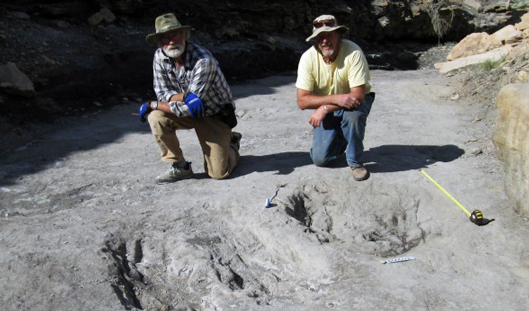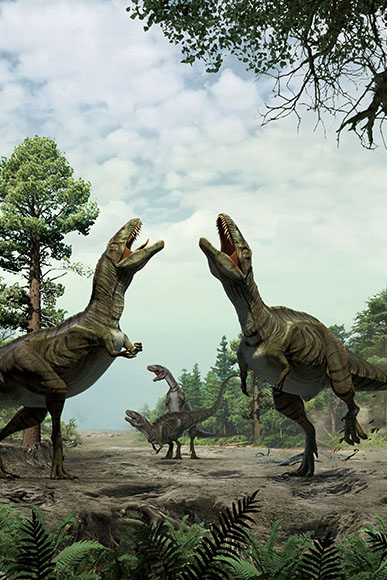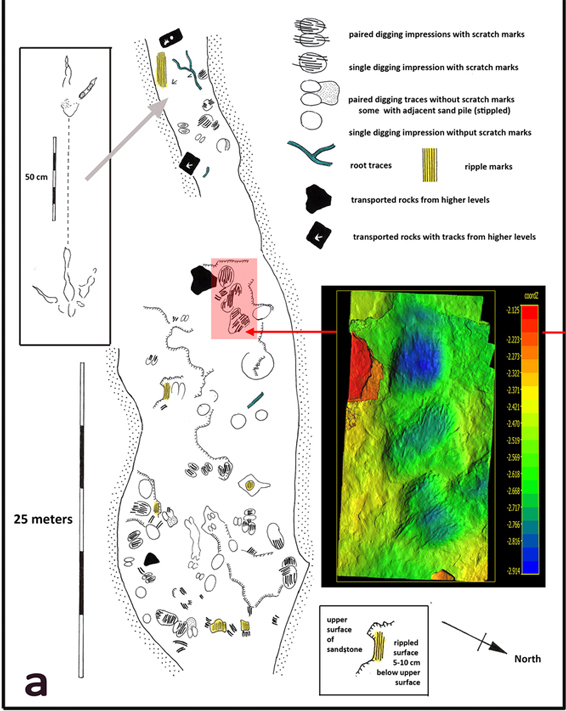Dance of the Dinosaurs
A Dinosaur Goes a Wooing?
The link between the Dinosauria and birds is well established. However, to what extent can we view the behaviour of our feathered friends today and infer behaviours in the long extinct dinosaurs? Thanks to some new research published this week in the academic journal “Scientific Reports”, palaeontologists may have gained an insight into the courtship and mating behaviours of theropod dinosaurs.
Courtship and Mating Behaviours of Theropod Dinosaurs
The research team, which included scientists from South Korea, China, Poland as well as the United States, conclude that trace fossils consisting of gouges and scrapes preserved in sandstone strata that is estimated to be around 100 million years old, preserve evidence of dinosaurs engaging in courtship and mating behaviours similar to extant birds. The scrapes, gouges and scratches, some of which cover an area the size of a bathtub, have been interpreted as being similar to “nest scrape display” as seen in modern Aves.
Dinosaurs Displaying and Undertaking Ritualised Courtship Displays
Picture credit: (Lida Xing and Yujiang Han / University of Colorado, Denver)
Dance of the Dinosaurs
The study was led by Professor Martin Lockley (University of Colorado) a highly respected specialist in dinosaur tracks and footprints (ichnologist). The team interpret the trace fossils as evidence of courtship behaviour in theropod dinosaurs as the dinosaurs demonstrated their ability to make suitable mates by excavating pseudo nests. Various trace fossil sites were studied and mapped, most of which are associated with the Upper Cretaceous deposits of the Dakota sandstone and mudstone formation of western Colorado.
Professor Lockley explained:
“These are the first sites with evidence of dinosaur mating display rituals ever discovered, and the first physical evidence of courtship behaviour. These huge scrape displays fill in a missing gap in our understanding of dinosaur behaviour.”
Scientists Provide a Sense of Scale to the Scrape Marks

Martin Lockley (right) and co-author Ken Cart pose beside large theropod dinosaur scrapes in western Colorado.
Picture credit: University of Colorado
Could They Be Signs of Digging for Water or Food?
In their review of the trace fossil evidence, the scientists dismiss the idea that the marks could have been made by meat-eating theropod dinosaurs looking for food. Back in 2010, Everything Dinosaur reported on a remarkable trace fossil found in Utah which suggested that a deinonychosaurid dinosaur had been digging out a potential prey animal from its burrow. However, no evidence of burrows or other signs of prey were found in association with the scrapes.
To read about the evidence of a dinosaur potentially digging mammals out of their burrow: Trace Fossils Suggest a Dinosaur Digging for its Supper.
Not “Scratch Digging”
As for whether the marks represent dinosaurs digging for water, after all much of the Dakota sandstone and mudstone was laid down in association with rivers and streams, the researchers conclude that this is unlikely. Whilst elephants and other terrestrial vertebrates do dig into dried up river beds to find water, the authors conclude that these marks are not “scratch digging” as any attempt to dig to the level of the water table would produce a pooling of water which would have washed away any scrape marks made in the sediment.
A Map of One of the Study Sites (Club Gulch – Western Colorado)

Map of Club Gulch site (a) prepared in Photoshop CS5 by MGL, with natural colour photogrammetic image (b) at same scale by RTM and LGB. Coloured image (inset in a) shows three large scrapes, together covering 5 m. Digging traces are classified as paired (bilobed) or single, with or without scratch marks and adjacent sand aprons.
Picture credit: Scientific Reports
Dance of the Dinosaurs in “Leks”
The display arenas, also referred to as “leks” were found in two National Conservation Areas (Dominguez-Escalante and Gunnison Gorge) on property permitted by the Bureau of Land Management near Delta, Colorado. The biggest site had approximately sixty preserved scrapes, located in a single bed of sandstone covering an area of 750 square metres. The scientists also studied potential dinosaur mating/courtship fossil sites at the Dinosaur Ridge, a National Natural Landmark, just west of the city of Denver.
It is assumed that the males competed with each other to impress the females. The females, choosing the most impressive male performers as their consorts. Similar mating selection behaviours are common in tetrapods alive today, however, until now scientists could only speculate about dinosaur mating behaviour although in theropods at least, it had been assumed it might be similar to that of their modern avian relatives.
Dinosaurs Strutting Their Stuff
The discovery of a number of feathered varieties including oviraptorids with ornate tail feathers has led a number of palaeontologists to speculate that some theropod dinosaurs performed elaborate displays in order to win a mate or to gain status amongst the flock. Research from the University of Alberta (Canada), proposed that some dinosaurs had compressed tail vertebrae that formed a pygostyle, as seen in many extant birds. This structure would have enabled the dinosaurs to shake their tail feathers.
To read an article that provides more detail on this research: Dinosaurs Shaking Their Tails.
Commenting on this new study, Professor Lockley stated:
“The scrape evidence has significant implications. This is physical evidence of pre-historic foreplay that is very similar to birds today. Modern birds using scrape ceremony courtship usually do so near their final nesting sites. So, the fossil scrape evidence offers a tantalising clue that dinosaurs in ‘heat’ may have gathered here millions of years ago to breed and then to nest nearby.”
A Line Drawing with Key of One of the Trace Fossil Sites Studied
Picture credit: Scientific Reports



